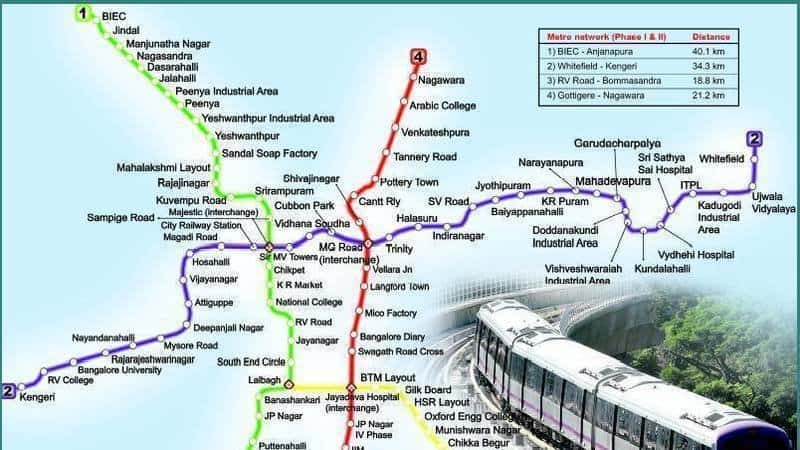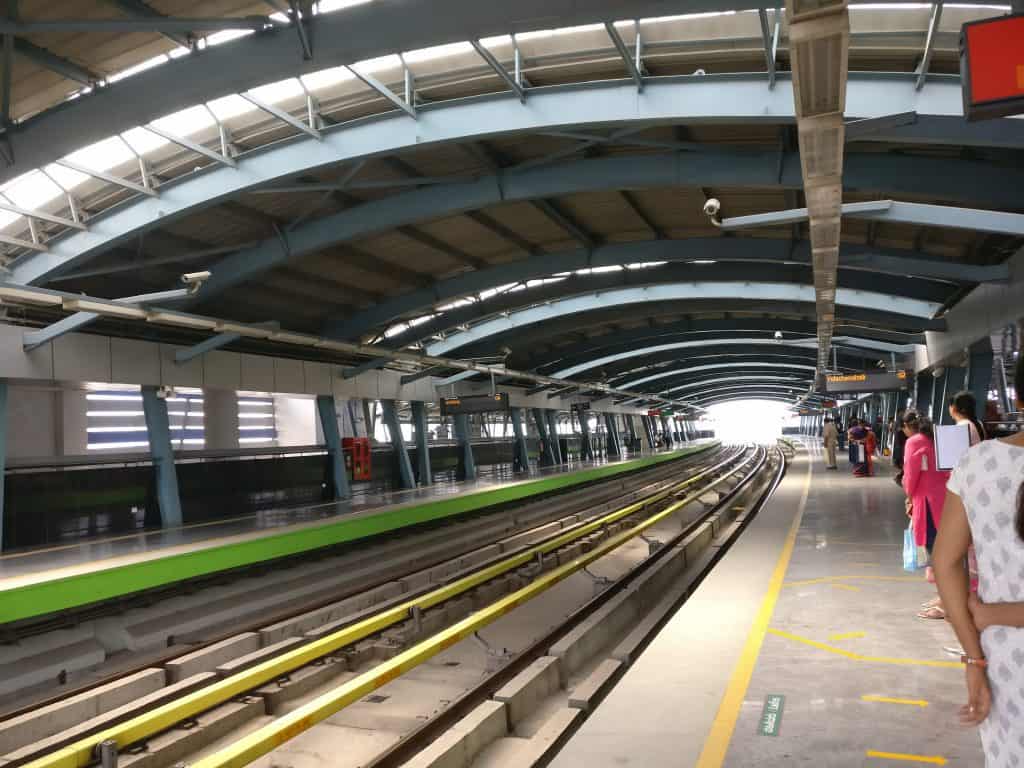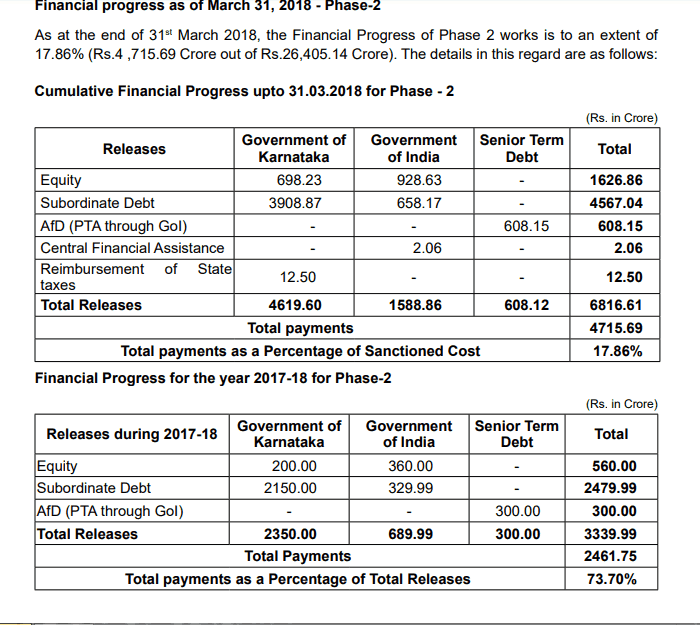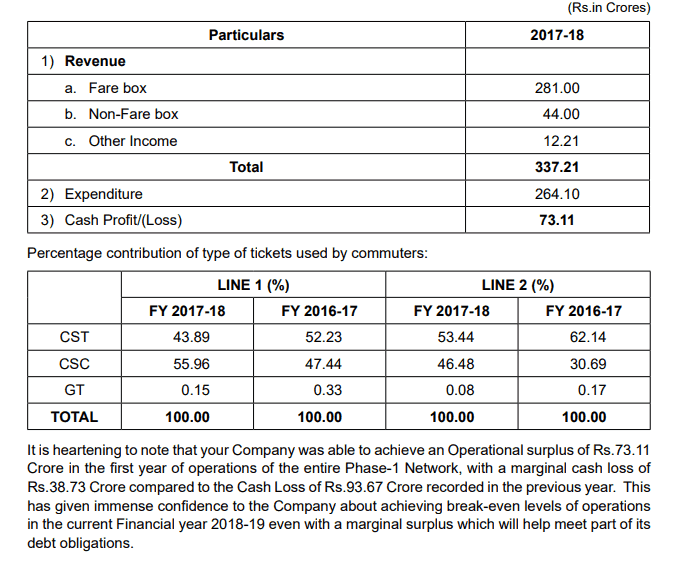Bengaluru Metro Rail Corporation Ltd (BMRCL) has released its 2017-18 annual report online last week in its entirety. The report details BMRCL’s efforts to keep up the pace of construction and other issues.
Six new stretches of the Metro cover 72 km and 61 stations. Two extensions of the already existing purple line on the west and east sides, two extensions of the already operational green line on the north and south sides, and establishment of the new Yellow Line and Red Line form six stretches totally. While the civil contracts have been awarded for all the depots costing Rs 250 crores each excluding Baiyappanahalli, the cost of the mechanical work ranges from 50 to 55 crores. The report also explains the green initiatives planned by Metro, like lake maintenance and rainwater harvesting.
Credit: https://themetrorailguy.com/bangalore-metro-information-map-updates/
The report also lays out plans for Phase 3 of the Metro. Chief Minister of Karnataka had announced in February 2018 that this would make the Metro network a Ring Network.
DPR for #NammaMetro Phase 3 will be launched soon, taking the total length to 266 kms. Upon completion, Namma Metro will become a ring rail network in the city. #NavaKarnatakaBudget2018 #NavaKarnatakaNirmana pic.twitter.com/2nxzLcE5SP
— CM of Karnataka (@CMofKarnataka) February 16, 2018
The annual report explains that phase 3 of Namma Metro would be a circular line connecting important areas like Ring Road, South East areas of Bengaluru, Old Madras Road and Sarjapur Road. A radial corridor along Magadi Road and Old Madras road also has been envisaged for which consultants have submitted the feasibility reports.
The table below outlines Phase 2 and the status of each line. Info source: BMRCL annual report and media coverage.
| Names of the line | Stations | km | Depot | Direction | Tenders | Packages |
| Baiyappanahalli to ITPL | 14 | 15.50 | Baiyappanahalli (44.75 acres) | Extension of East End of Purple Line | In talks | 3 |
| Mysore Road Terminal to Kengeri | 5 | 6.465 | Challaghatta
(38.92 acres) |
Extension of West End of Purple Line | IL & FS Engineering and Construction Company and Soma Enterprise Ltd | 2 |
| Hesaraghatta cross to BIEC | 3 | 3.77 | Extension of North End of Green Line on Tumkur road | Simplex Infrastructure Limited | 1 | |
| Puttenahalli Cross to Anjanapura up to NICE road | 5 | 6.29 | Anjanapura (8.88 acres) | Extension of South End of Green Line along Kannakpura road | NCC Limited | 1 |
| RV Road to Bommasandra | 16 | 18.82 | Hebbagodi (39.26 acres) | Yellow Line | ITD CEMENDIA and HCC -URCC | 3 |
| Gottigere-Nagawara-IIMB | 18 | 21.25 | Kothanur /
Kadugodi (31,49 acres) |
Red line | Simplex Infrastructure Limited for 7 km of elevated stations | 5 |

Map of Phase 2, Pic: bmrc.co.in
So, how much headway has the BMRCL really made?
Land acquisition till date on public record
Out of 126.28 hectares of land that needs to be transferred to BMRCL, the majority will depots in Baiyapannahalli, Hebbagodi, Anjanapura, Kothanur and Challaghatta. This proves to be a challenge as 88.22 hectares are privately owned, while 38.06 hectares belong to the government.
In 2016, 41. 255 hectares of private land and 4.32 hectares of government land had been acquired, according to the annual report of 2016-2017 of BMRCL. As of 2018, 57 hectares of private land was acquired and six hectares of government land, says the recent annual report of 2017-2018.
| Private land | Government land | |
| In total | 88.22 hectares | 38.06 hectares |
| 2016-17 | 41.255 hectares | 4.32 hectares |
| 2017-18 | 57 hectares | 6 hectares |
Shifting deadlines, broken promises
Even while Bengaluru struggles without efficient public transport systems, the construction of Bangalore Metro Rail Project-Phase 2 continues to lag behind extended deadlines.
The annual report 2016-17 published by BMRCL says: “The company is confident of completing the Phase-2 of the project by 2020.” The statement could be true for two of the six proposed stretches. In a meeting held at the Vidhana Soudha last month, Deputy CM G Parameshwara announced the revised deadlines. He said that by 2020, Mysore Road-Kengeri and Nagasandra-BIEC stretches will be ready.
It is, however, going to take another year for two other stretches: Baiyappanahalli-Whitefield and RV Road-Bommasandra will be ready the following year in 2021. Gottigere-Nagawara stretch will take the longest to complete by 2023, while Yellachenahalli-Anjanapura will be complete by 2019. The annual report of 2017-18 reiterates his promises. More recently, the Chief Minister was of the same view.

Metro has not been able to adhere to the original deadlines set in the tender documents and work orders. Pic: Shree D N
Not meeting the deadline has become a pattern over the years even as the government has pushed the project forward from the start. The first target was slated to be five years after the date of approval by the Government of India. Information available on the urban development department’s website says that an in-principal approval on 21/02/2012 was given for the government order number (UDD 179 PRJ 2011). Two years later, the official approval was given on 21/2/2014 in a letter addressed to the Chief Secretary of the Government of Karnataka. This time, the letter clarified that the deadline was applicable from the date of starting construction.
Rising costs delay the project
The entire cost of the project in the detailed project report (DPR) prepared by Delhi Metro Rail Corporation roped in by GoK was Rs 26,405.14 crore in 2011, with an escalation cost of 5% per annum, including central and state taxes and duties. The Deputy CM admitted that the price has now reached Rs 32,000 crore in 2018.
The price of compensation has risen to 6,000 crores which is to be entirely funded by the government in the form of subordinate debt, of which Rs 3,077.15 crores have been already awarded. 1790 properties of the estimated 3011 properties had been acquired, said this media report. The cost for compensation and rehabilitation was Rs 2003.80 crores back in 2016, of which 1476.54 crores was said to have been given according to the annual report that year.
The updated annual report of this year shows the financial progress of phase 2 against the previous budget of Rs 26, 405 crores. In the funding pattern of Phase-2, 30 % is borne by the state government, 25% by the Centre and rest of the 45% is financed from external sources in the form of senior debt. So far, 4715.69 crores has been utilized towards the project as of 31 March 2018.
The annual report says that expenditure was Rs 264.1 crores as against the revenue earned of Rs 337.21 crores. BMRCL has managed to make a profit of 73.11 crores from that difference in 2017-18, after nearly six financial years. Since losses amounting to Rs 38.73 crores and Rs 93.67 crores were recorded in the last two financial years, the profit is likely to only go towards clearing debts.
The revenue generated from tickets in 2017-18 has increased to Rs 281 crores, due to rise in the number of daily trips from 206 to 298 trips made in one year and increased passenger intake. On good days, 4 lakh or more ridership is registered by the Green and Purple Lines combined.
The revenue generated from the non-fare stream, by providing space for events, advertisements, sponsorship and property development, has increased from Rs 20.18 crores to Rs 40 crores in one year, says this report. Below is the table attached from the annual report, showing the details of the income generated.

This table shows the pattern in the type of card purchases: contactless smart tokens (CST), contactless smart cards (CSC) and group tickets (GT). The data shows that smart cards formed 55.96 % of the total tickets for line 1, while the same for line 2 is 46.48 %.

Instead of waiting for all stations to complete, pls open one by one as soon as it gets completed. If KR Puram is completed please open and allow trains to ply. Why to wait till Whitefield is finished?
All you have talked about is the annual report. There’s nothing about the circular metro, which is mentioned in the Headline.
Much is heard /written about inter change – Kempegowda /Majestic /Metro Station . if trains can change track – i.e if Nayandahalli -Byappanhalli can turn towards peena/Yelachenhalli and Yelchenhalli- Nagasandra can go to Byapanhalli it will be of great help to Bangalore commuters avoid huge rush, physically changing trains at the Majestic/ K.G.Station.
Wasn’t the Nagawara to Airport line shifted to go via Hebbal to avoid the high pressure gas line at Jakkur Main road? The_metro_guy has not updated the map.
Where is the reference to the circular metro mentioned in the headline?